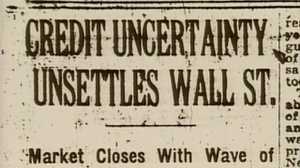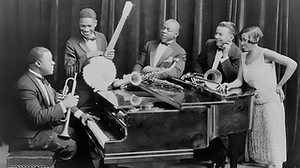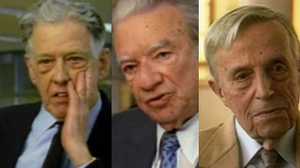A Selected Wall Street Chronology

1653: Early History
Dutch colonists construct a wooden stockade across lower Manhattan to protect the north side of their settlement against attacks by the British and Indians. By the turn of the 18th century, the British have taken over the colony and dismantled the barrier, turning it into a paved lane called Wall Street.
September 21, 1776
A devastating fire, probably the work of colonial arsonists trying to disrupt the British occupation of the city during the American Revolution, destroys hundreds of structures in the vicinity of Wall Street.
January 14, 1790
In his landmark Report on the Public Credit, the young nation’s first treasury secretary, Alexander Hamilton, proposes a method for the U.S. to handle federal and state debt by issuing government bonds, and establishes the principle of free trade for securities in the marketplace.
August 1790
Brokers meet in Philadelphia, where they buy and sell the first major issues of publicly-traded securities: $80 million in bonds issued by the federal government to pay off debt from the Revolutionary War.
May 17, 1792
At the Merchants’ Coffee House at the corner of Wall and Water Streets, two dozen New York City stockbrokers and merchants sign the “Buttonwood Agreement,” named after a buttonwood tree under which business has been transacted in the past. The agreement lists rules for securities transactions.
1793
The locus for securities transactions in New York moves to the Tontine Coffee House, across the street from the Merchants’ Coffee House. Business is also transacted on the street.
March 8, 1817
A group of New York brokers formally establish the New York Stock and Exchange Board, an organization that later will be renamed the New York Stock Exchange (N.Y.S.E.).
1829
5,000 Shares a Day
The stock market reaches a trading volume of 5,000 shares a day.
December 16, 1835
On a bitterly cold night, a fire starts in lower Manhattan. Raging for two days, it will destroy 700 buildings, including the Merchants’ Exchange.
September 12, 1836
The N.Y.S.E. bars its members from conducting business in the streets.
March 22, 1837
The N.Y.S.E. starts paying its president a salary. The first paid president, David Clarkson, earns $2000 a year ($31,960 in 2003 dollars).
May 24, 1844
Samuel F. B. Morse transmits the first viable telegraph message. Securities brokers quickly adopt the technology to send market quotations. The telegraph helps expand the stock market by making trades accessible to brokers and investors outside of New York.
May 11, 1861
In response to the outbreak of the Civil War, trading of Confederate securities is banned.
July 27, 1866
Cyrus Field completes a transatlantic cable, connecting telegraph operators across the Atlantic Ocean. For the first time, London and New York markets can communicate instantaneously.
November 15, 1867
Edward Callahan invents the stock ticker, a device that shows current market prices and represents each company on the stock market with symbols based on Morse code.
September 24, 1869
Black Friday. A group of speculators led by Jay Gould and Jim Fiske try to corner the gold market, setting off a U.S. financial panic.
September 18, 1873
The brokerage firm of Jay Cooke & Company, a major investor in new railroad construction, collapses, sparking the Panic of 1873.
November 13, 1878
The N.Y.S.E. installs the first telephones on its trading floor.
November 1882
Dow Jones & Company
Charles Dow and Edward Jones form Dow Jones & Company and design the first index to measure the activity of the N.Y.S.E.
May 6, 1884
The Wall Street brokerage firm of Grand and Ward fails, leading to a panic and the failure of 15 other stock exchange firms. Grant and Ward is co-owned by Buck Grant, the son of former Union general and president Ulysses S. Grant, and the failure plunges the ex-president into bankruptcy. Desperate for money, he will begin writing his wartime memoirs soon afterward.
December 15, 1886
The N.Y.S.E.'s trading volume reaches one million shares a day for the first time.
April 8, 1890
Junius S. Morgan, the head of the Morgan banking family, dies. His son, John Pierpont Morgan, will turn the family financial empire into one of the most powerful banking houses in the world.
May 26, 1896
Charles Dow reveals his industrial stock average in the first publication of his daily paper — the Wall Street Journal. Dow Jones creates four averages to measure market performance, including the Dow Jones Industrial Average.
January 12, 1906
The Dow Jones Industrial Average closes the day at over 100 for the first time.
October 21, 1907
Rumors of financial problems at a leading New York bank trigger investors to run on banks throughout the city, beginning the Panic of 1907. J. P. Morgan devises a plan to return cash to banks, saving the country from its most severe financial crisis to date.
February 28, 1913
The Pujo Committee, appointed by Congress to investigate practices of the banking and securities industry, issues a report which leads Congress to create the Federal Reserve System. The Fed is designed to stabilize the nation’s banking structure.
July 31, 1914: WWI Begins
World War I begins in Europe, leading to sharp declines in world stock prices. The N.Y.S.E. and exchanges throughout the world temporarily suspend trading in order to stop prices from dropping further.
April 7, 1917
Following a series of German provocations, President Woodrow Wilson asks Congress for a formal declaration of war. The U.S. enters World War.
June 8, 1917
A liberty loan rally is held on the trading floor of the N.Y.S.E., where former president William H. Taft encourages Americans to purchase war bonds.
November 11, 1918
The United States emerges from World War I as a creditor nation and a rising global force.
October 1923
A bull market begins. It will continue growing for nearly six years.
April 13, 1928
The N.Y.S.E. introduces new and improved high-speed tickers. The devices can print 500 characters per minute, almost twice as fast as the earlier models.
February 1929
Astrologer Evangeline Adams, who counts Charlie Chaplin, Mary Pickford, and J. P. Morgan among her clients, predicts the market will rise in the coming months.
March 15, 1929
Newspapers quote Treasury Secretary Andrew Mellon saying there are bargains to be found in the bond market. Wall Street is in the midst of a buying frenzy. As the market rises, some begin to fear it will soon collapse. The Federal Reserve Board meets, but does not make any public statements.
March 4, 1929
President herbert Hoover is inaugurated. Nicknamed “The Great Engineer,” the former geologist and mining engineer takes office amid booming prosperity. During the campaign, he has promised: “We shall soon, with the help of God, be in sight of the day when poverty will be banished from this nation.”
March 8, 1929
Michael J. Meehan begins one of the most successful brokerage pools in Wall Street history. Over the next ten days, he drives the value of R.C.A. stock up almost 50%. In today’s money, his pool will make the colluding investors $100 million.
March 25, 1929
A mini-crash begins as investors start to sell, revealing the market’s shaky foundations. For the many people playing the market with borrowed money, the day is a disaster, as margin calls wipe out their holdings. While the investors seek to borrow more money, interest rates soar to 20 percent. The New York Daily News calls it a “selling avalanche.”
March 27, 1929
Banker Charles Mitchell announces that the national city bank will provide $25 million in credit to stop the market’s slide. His move stops the panic, and call money declines from 20 to eight percent. Senator and former Treasury Secretary Carter Glass calls for Mitchell to resign from his post on the Federal Reserve Board because of his intervention in the market.
Spring, 1929
The American economy shows ominous signs of trouble. Steel production is declining, construction is sluggish, car sales are down, and consumers are building up high debts because of easy credit. Yet the stock market continues its upward momentum, heedless of real economic indicators.
May 14, 1929
The N.Y.S.E. opens a new bond room, adding 6,000 feet to the trading floor.
Summer, 1929
The market continues to rebound, and stocks hit record levels month after month.
August 17, 1929
Michael Meehan’s brokerage firm launches a new service: an office aboard ocean liners, including the Berengaria. This convenience allows transatlantic passengers to buy or sell shares during the weeklong passage between the U.S. and Europe.
September 3, 1929
The Market Reaches its Peak
After a surge of optimism, the bull market reaches its peak — the Dow Jones Industrial Average closes at 381.17. A newspaper headline trumpets, “Public Demand for Stock Appears Insatiable.”
September 5, 1929
Bearish economist Roger Babson gives a speech, saying, “Sooner or later, a crash is coming, and it may be terrific.” He has been delivering this message for two years, but for the first time, investors listen. The market takes a severe dip, which will be called the “Babson Break.” The next day, prices will stabilize, but the collapse has begun.
Mid-September, 1929
The market fluctuates wildly up and down.
October 24, 1929
“Black Thursday.” The economic bubble finally bursts. Stock prices fall sharply on a day of heavy liquidation. Ticker tape runs four hours later than normal at a volume of 12.9 million shares. Headlines will report the market’s paper loss at $5 billion. A pool of bankers acts to stem the drop by putting more money into the market, and President Hoover reassures Americans that U.S. business is sound. Within a few days, a headline will read, “Brokers Believe Worst is Over and Recommend Buying of Real Bargains.”
October 28, 1929
“Black Monday.” The stock market falls 22.6%, the highest one-day decline in U.S. history. The crash triggers similar declines in markets around the world.
October 29, 1929
“Black Tuesday.” Panic sets in as investors all try to sell their stocks at once. Over 16 million shares of stock are sold, setting a record — and the market records over $14 billion in paper losses. Stock tickers cannot keep up with the heavy trading volume. At the end of the day, the market is down 33 points, more than 12.8%. Some of the nation’s financial elite, including General Motors’ William C. Durant and the Rockefeller family, show confidence by buying stocks, but their efforts fail to stem the tide.
November 23, 1929
After weeks in freefall, the market hits its bottom and stabilizes. The New York Times reports, “Regular Schedule to be Resumed, but Trading Will Be Suspended Last Half of Week; Business Nearly Normal.” The market’s daily volume is at 3 million shares with “orderly although irregular” prices.
January 7, 1931
A report released by the Committee for Unemployment Relief states that over four million Americans are unemployed.









